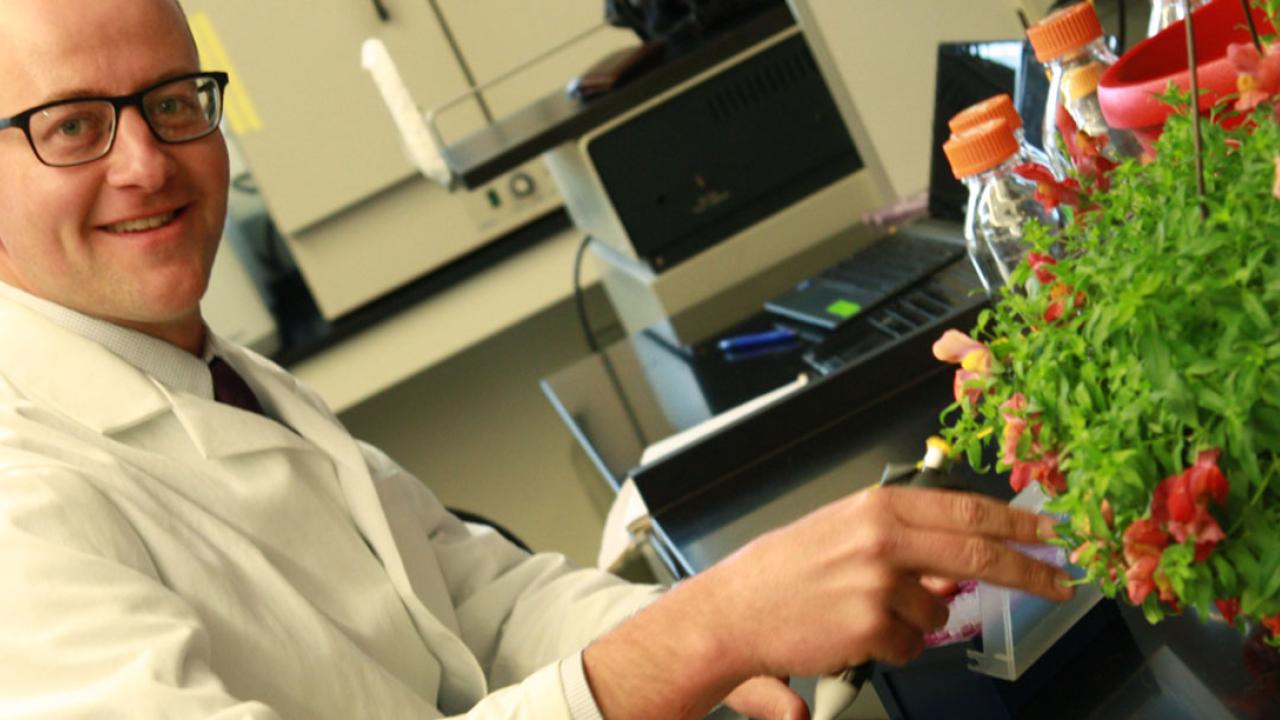Petunias come in so many vibrant varieties; it’s hard to decide which color to buy. One day soon, you might not have to choose.
A UC Davis alumnus is helping develop “Petunia Circadia,” a flower that changes colors throughout the day — red in the morning, blue in the evening, and shades of purple in between.
“No chemicals, no complicated care, just sunlight, soil and a flower that changes color,” said Nikolai Braun, co-founder and chief scientific officer of a new biotech company, Revolution Bioengineering.
“We want to show people that science is beautiful, and highlight the possibilities with this new field.”
It’s called ‘synthetic biology’
This new field is called synthetic biology, a modern form of genetic engineering, where engineering principles are applied to living systems to develop new biological functions. In the case of Petunia Circadia, Braun and his business partner, Keira Havens, will modify the environment of petunia molecules that regulate flower color.
“Plants have circadian rhythms, or cyclical expression of genes throughout the day,” explained Braun, who received his doctorate in plant biophysics at UC Davis in 2007.
“These rhythms allow them to start photosynthesis when the sun comes up, for example, or release fragrance in the evening when their pollinators are active. Petunia Circadia will harness this internal clock to regulate flower color.”
Science could address global warming
Similar science could be used to address a variety of environmental issues, like global warming. If you can engineer a flower that changes color, for example, you could conceivably develop a plant that absorbs more carbon dioxide from the atmosphere.
“We’re not saving the world; just making a cool, pretty thing,” Braun said. “But maybe it can influence public opinion about GMOs.”
GMOs, or genetically modified organisms, inspire contentious debate, especially around food crops like corn and soybean. Major science societies, including the National Academy of Sciences and the World Health Organization, have concluded that the technology is safe and that GMO crops on the market are safe to eat.
But anti-GMO activists disagree, saying they represent corporate control of our food system. The “non-GMO” label is among the fastest growing categories of product sales in the nation.
A technology that can feed the world
Meanwhile, scientists like UC Davis Professor Pam Ronald, plant geneticist at UC Davis, continue to use this new technology to improve the environment and feed the world.
Recently, for example, Ronald and her colleagues developed genetically engineered bananas resistant to Xanthomonas wilt disease which decimated millions of acres of fruit trees in East Africa, where 100 million people depend on bananas as their staple food source.
She points to other researchers who have used genetic engineering as a tool to help farmers and consumers.
“For example, there are millions of malnourished children around the world, and golden rice (genetically engineered rice that expresses disease-fighting carotenoids) can help save lives,” Ronald said.
“Genetically engineered crops on the market such as GE papaya, Bt cotton and Bt corn are vital to fighting crop diseases and reducing insecticide use.”
Can a color-shifting flower help?
Braun and Havens have reached out to Ronald as they develop their colorful petunia. She says she’s happy to offer support.
“It can be hard to connect to the reality of people struggling in far-away places,” Ronald said. “So when you tell people that genetic engineering can be used to fight hunger by increasing vitamin content and reducing crop loss to insects, sometimes it just doesn’t register. Maybe seeing this technology at work in your own backyard can make the science more accessible.”
That’s the plan. Petunia Circadia is still in the development stage, but Braun and Havens got a big lift for their young venture recently when they were chosen to join the inaugural class of Ireland-based SynBio axlr8r, a business accelerator program for biotech start-ups using synthetic biology.
$60,000 and mentoring
SynBio axlr8r awarded them $60,000 in cash and mentoring to help make their idea a reality.
As part of the program, Braun and Havens have moved from their company’s home base in Fort Collins, Colo., to spend three months in Cork City, Ireland, near University College Cork, where they have full access to the molecular biology lab and other university facilities.
“It’s great, because for three months, we have everything we need to really go after this,” Braun said.
They plan to pitch their petunia idea to investors in San Francisco in September. If everything goes right, their color-shifting flower may be coming soon to a nursery near you.
